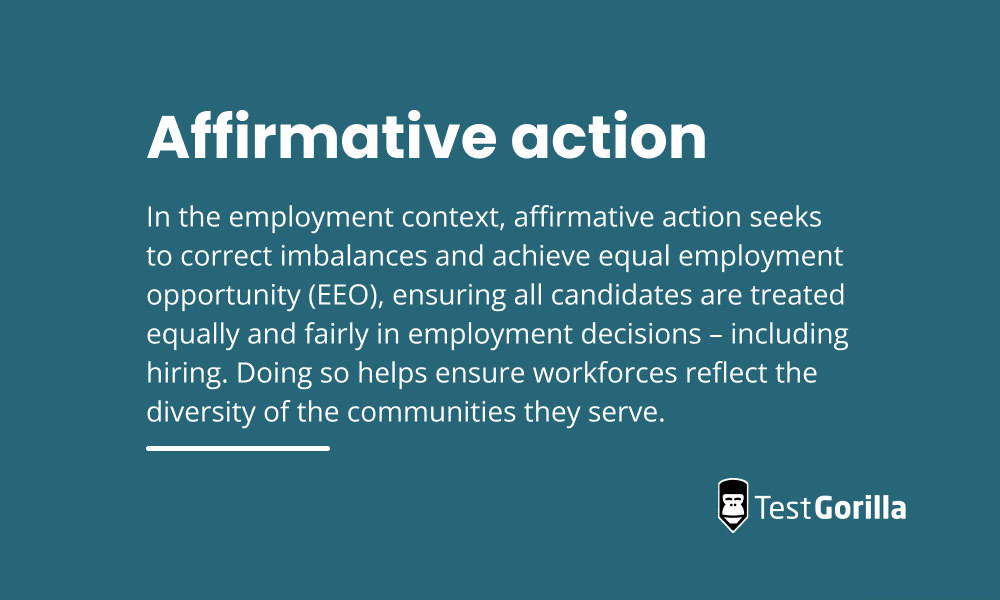Promoting diversity and inclusion in your workplace is essential for ensuring everyone has equal access to employment opportunities. Affirmative action plays a crucial role in achieving this, but laws surrounding this practice are complex. And noncompliance can lead to costly discrimination complaints and lawsuits.
To use affirmative action, you must comply with strict criteria. Navigating your responsibilities can be tricky.
We can help you get started. Our article provides some background on affirmative action in the US and the relevant laws that may apply to your hiring processes. Additionally, we touch on the Supreme Court’s 2023 decision and its potential impact on employers and workplace diversity.
We also explain why you should seek legal advice tailored to your situation before implementing affirmative action in your organization.
Table of contents
What is affirmative action in the United States?
Affirmative action refers to policies and programs designed to address historic discrimination against specific protected groups, including racial minorities, women, people with disabilities, and veterans.
Typically used by businesses and universities, affirmative action aims to promote fair representation and overcome systemic barriers faced by traditionally underrepresented groups.
In the employment context, affirmative action seeks to correct imbalances and achieve equal employment opportunity (EEO), ensuring all candidates are treated equally and fairly in employment decisions – including hiring. Doing so helps ensure workforces reflect the diversity of the communities they serve.
Affirmative action enables businesses to take certain steps to support the full and equal participation of underrepresented groups.
Examples of steps organizations may take include:
Using outreach programs – for example, reaching out to female candidates through local university job fairs
Delivering training programs to individuals from underrepresented groups to develop their job-related skills and knowledge
Setting affirmative action goals, tracking the representation of a specific group, and adjusting policies and procedures to achieve your organization’s goals
In the past, affirmative action involved hiring quotas: numerical targets. For instance, a tech firm might’ve required at least 15% of its new engineering hires to be women in its effort to address the gender imbalance in the tech industry. However, quotas were later found unconstitutional, which prohibited their use in hiring.
Affirmative action is a complex social issue. A 2019 Pew Center study highlights this, with 75% of respondents saying it’s very or somewhat important for employers to promote racial and ethnic workplace diversity. However, in the same study, a majority (74%) said race and ethnicity shouldn’t be considered in hiring and promotional decisions.
The issue is also legally complex. Employers are prohibited from discriminating against candidates based on protected characteristics like race, gender, and religion. By using affirmative action to support minorities, your organization may also attract allegations of discrimination against other groups. For example, an organization that targets female applicants might be accused of discriminating against male applicants.
However, the Equal Employment Opportunity Commission (EEOC) – an independent federal agency that enforces federal anti-discrimination laws – explains, “Affirmative action under the [EEOC] Guidelines is not a type of discrimination but a justification for a policy or practice based on race, sex, or national origin.”
Arguments for affirmative action
Supporters of affirmative action argue it contributes to EEO by countering the lasting effects of historical and systemic inequalities. Both conscious and unconscious biases still exist and impact the hiring process. Supporters view affirmative action as a valuable tool for overcoming such biases.
Proponents also say that affirmative action is key to achieving true workplace diversity. Plus, they emphasize such measures are necessary for as long as they’re needed to correct imbalances only.
For example, bias may cause some employers to believe candidates who use wheelchairs are less capable of performing desk-related tasks than candidates who don't. Affirmative action measures aimed at increasing employment opportunities for candidates with disabilities could help companies overcome such biases.
Arguments against affirmative action
Opponents of affirmative action say it’s counterproductive. By giving preferential treatment to specific groups, you necessarily discriminate against other groups and create wider divisions. Those against affirmative action argue that more effective ways to address historical inequality – like anti-discrimination laws – exist.
Critics also say that affirmative action grants access to employment opportunities based on characteristics unrelated to merit. This undermines the principle of selecting candidates based on their qualifications and abilities.
For example, consider an employer who hires a racial minority over a more-qualified non-minority candidate. Hiring decisions viewed as being based solely on factors like race can lead to perceptions of unfairness and worse.
Is affirmative action legal?
Initially introduced by President Kennedy through an executive order in 1961, affirmative action as a legal concept has since faced numerous challenges in the courts. Also, different administrations take varying approaches to this practice and demonstrate differing levels of support for it.
As a result, the law on it constantly evolves.
Federal law
Federal law allows affirmative action plans, including documents that outline an organization’s approach to proactively recruiting, hiring, and promoting protected groups like minorities, women, and candidates with disabilities. Some affirmative action plans are voluntary, while others are mandatory.
Voluntary affirmative action (private employers)
Title VII of the Civil Rights Act allows private employers to use affirmative action plans voluntarily. For these plans to be legal, they must meet specific criteria:
They must aim to address a racial or gender imbalance in traditionally segregated job categories
They must be temporary and apply only for the time needed to address the imbalance
They can’t unnecessarily interfere with the interests of other non-minority employees
To implement an affirmative action plan, you must also follow the EEOC guidelines. Doing so helps reduce the risk of affirmative action resulting in discrimination.
These guidelines require employers to:
Conduct a self-analysis to identify specific policies or practices that have limited, excluded, or restricted employment opportunities for minorities and women
Have a reasonable basis for deciding that affirmative action is appropriate
Prepare a plan that’s reasonable with regard to the policies or practices identified in the self-analysis
The EEOC also sets other criteria, such as using the plan for only as long as necessary, narrowing its scope to the identified issues, and ensuring the plan is documented and dated.
Mandatory affirmative action (federal contractors and subcontractors)
Various mandatory affirmative action laws exist at the federal level. Here are some:
Executive Order 11246 includes a requirement for affirmative action by federal contractors
Rehabilitation Act of 1973 requires federal contractors to take affirmative action to employ qualified individuals with disabilities
Vietnam Era Veterans’ Readjustment Assistance Act of 1974 requires federal contractors to take affirmative action to employ veterans
Under federal law, certain federal contractors and subcontractors must prepare written affirmative action plans and update them yearly. Coverage under these laws depends on the contract’s nature and size and the contractor’s number of employees.
These laws also place administrative and reporting obligations on covered contractors, including:
Keeping specific employee records
Asking applicants to self-identify race, gender, disability, or veteran status voluntarily
Reporting demographic data for applicants and employees
Construction contractors don’t need to prepare written affirmative action plans. However, certain construction contractors must implement 16 affirmative action steps, including strategies targeted at recruiting minority and female candidates and annual reviews of supervisors’ compliance with EEO policies and affirmative action requirements.
The Office of Federal Contract Compliance Programs (OFCCP) oversees mandatory affirmative action plans. Its website provides various compliance guides for federal contractors.
States
Several states have banned affirmative action in the context of public employment (employment by a government department or agency), government contracts, and public university admissions. These include:
Arizona
California
Florida
Idaho
Michigan
Nebraska
New Hampshire
Oklahoma
Washington
What the June 2023 Supreme Court decision means for businesses
A recent Supreme Court decision has raised questions about employers’ use of affirmative action.
In Students for Fair Admissions v. Harvard University and Students for Fair Admissions v. University of North Carolina, the Supreme Court said affirmative action based on race in the college admissions system was unconstitutional. The Court found the policy violated the Equal Protection Clause of the Fourteenth Amendment, which guarantees all individuals equal protection under the law.
The ruling doesn’t directly apply to private employers and their affirmative action plans. The case examined Title VI of the Civil Rights Act, whereas Title VII covers private employers.
However, there are concerns the ruling may open the door to future legal challenges against employers’ use of affirmative action. This doesn’t require you to stop your current affirmative action policies – so long as they comply with federal and state laws. However, it presents a potential legal risk you should monitor for future developments.
The case has other indirect consequences for employers. Many businesses rely on universities to produce diverse, qualified talent. This Supreme Court decision will likely change the demographics of students, reducing the diversity of candidates leaving university and entering the workforce.
To sustain diversity in your applicant pool, ensure you use a range of strategies that support workplace equality. Examples include using unbiased recruitment methods and giving your hiring team diversity training.
What do I need to know about affirmative action and hiring?
Affirmative action can contribute greatly to fostering diversity in your hiring practices. But being aware of the strict laws around employers’ use of affirmative action is crucial to minimizing your legal risk.
Affirmative action is a very complex area of law. When preparing an affirmative action plan, seeking legal advice is essential. A lawyer can advise you of your specific legal obligations and offer strategies to reduce the risk of potential discrimination claims.
Pre-employment testing: another tool for workplace diversity
Affirmative action aims to address historical hiring inequalities and support diverse workforces. However, strict laws around affirmative action initiatives aim to ensure those initiatives don’t unintentionally discriminate against other groups.
Before implementing affirmative action in your organization, speak to a lawyer to understand your obligations. They can also help you craft a legally compliance affirmative action plan.
There are other ways to support diversity in your hiring process, including using pre-employment testing. Pre-employment testing provides subjective, bias-free insights into applicants by focusing on candidates’ job-related skills, capabilities, and cultural alignment.
At TestGorilla, we offer more than 400 scientifically validated tests, enabling you to create customized candidate assessments. To explore how TestGorilla can support fair hiring practices and build a diverse workforce, take a product tour or sign up for a free account.
Disclaimer
The information in this article is a general summary for informational purposes and is not intended to be legal advice. Laws are subject to constant change, and their applications vary based on your individual circumstances. You should always seek legal advice from a qualified attorney about your legal obligations as an employer. While this summary is intended to be informative, we cannot guarantee its accuracy or applicability.
Related posts
Hire the best candidates with TestGorilla
Create pre-employment assessments in minutes to screen candidates, save time, and hire the best talent.
Latest posts
The best advice in pre-employment testing, in your inbox.
No spam. Unsubscribe at any time.

Hire the best. No bias. No stress.
Our screening tests identify the best candidates and make your hiring decisions faster, easier, and bias-free.
Free resources
This checklist covers key features you should look for when choosing a skills testing platform
This resource will help you develop an onboarding checklist for new hires.
How to assess your candidates' attention to detail.
Learn how to get human resources certified through HRCI or SHRM.
Learn how you can improve the level of talent at your company.
Learn how CapitalT reduced hiring bias with online skills assessments.
Learn how to make the resume process more efficient and more effective.
Improve your hiring strategy with these 7 critical recruitment metrics.
Learn how Sukhi decreased time spent reviewing resumes by 83%!
Hire more efficiently with these hacks that 99% of recruiters aren't using.
Make a business case for diversity and inclusion initiatives with this data.


















